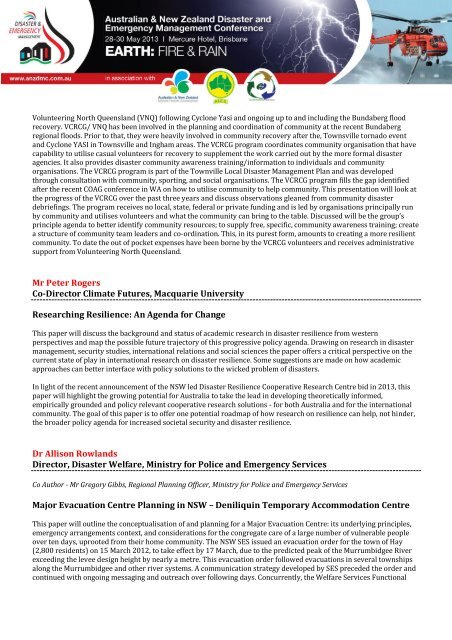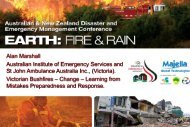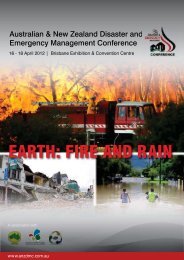Book of Abstracts 2013 - Australian and New Zealand Disaster ...
Book of Abstracts 2013 - Australian and New Zealand Disaster ...
Book of Abstracts 2013 - Australian and New Zealand Disaster ...
Create successful ePaper yourself
Turn your PDF publications into a flip-book with our unique Google optimized e-Paper software.
Volunteering North Queensl<strong>and</strong> (VNQ) following Cyclone Yasi <strong>and</strong> ongoing up to <strong>and</strong> including the Bundaberg flood<br />
recovery. VCRCG/ VNQ has been involved in the planning <strong>and</strong> coordination <strong>of</strong> community at the recent Bundaberg<br />
regional floods. Prior to that, they were heavily involved in community recovery after the, Townsville tornado event<br />
<strong>and</strong> Cyclone YASI in Townsville <strong>and</strong> Ingham areas. The VCRCG program coordinates community organisation that have<br />
capability to utilise casual volunteers for recovery to supplement the work carried out by the more formal disaster<br />
agencies. It also provides disaster community awareness training/information to individuals <strong>and</strong> community<br />
organisations. The VCRCG program is part <strong>of</strong> the Townville Local <strong>Disaster</strong> Management Plan <strong>and</strong> was developed<br />
through consultation with community, sporting, <strong>and</strong> social organisations. The VCRCG program fills the gap identified<br />
after the recent COAG conference in WA on how to utilise community to help community. This presentation will look at<br />
the progress <strong>of</strong> the VCRCG over the past three years <strong>and</strong> discuss observations gleaned from community disaster<br />
debriefings. The program receives no local, state, federal or private funding <strong>and</strong> is led by organisations principally run<br />
by community <strong>and</strong> utilises volunteers <strong>and</strong> what the community can bring to the table. Discussed will be the group’s<br />
principle agenda to better identify community resources; to supply free, specific, community awareness training; create<br />
a structure <strong>of</strong> community team leaders <strong>and</strong> co-ordination. This, in its purest form, amounts to creating a more resilient<br />
community. To date the out <strong>of</strong> pocket expenses have been borne by the VCRCG volunteers <strong>and</strong> receives administrative<br />
support from Volunteering North Queensl<strong>and</strong>.<br />
Mr Peter Rogers<br />
Co-Director Climate Futures, Macquarie University<br />
Researching Resilience: An Agenda for Change<br />
This paper will discuss the background <strong>and</strong> status <strong>of</strong> academic research in disaster resilience from western<br />
perspectives <strong>and</strong> map the possible future trajectory <strong>of</strong> this progressive policy agenda. Drawing on research in disaster<br />
management, security studies, international relations <strong>and</strong> social sciences the paper <strong>of</strong>fers a critical perspective on the<br />
current state <strong>of</strong> play in international research on disaster resilience. Some suggestions are made on how academic<br />
approaches can better interface with policy solutions to the wicked problem <strong>of</strong> disasters.<br />
In light <strong>of</strong> the recent announcement <strong>of</strong> the NSW led <strong>Disaster</strong> Resilience Cooperative Research Centre bid in <strong>2013</strong>, this<br />
paper will highlight the growing potential for Australia to take the lead in developing theoretically informed,<br />
empirically grounded <strong>and</strong> policy relevant cooperative research solutions - for both Australia <strong>and</strong> for the international<br />
community. The goal <strong>of</strong> this paper is to <strong>of</strong>fer one potential roadmap <strong>of</strong> how research on resilience can help, not hinder,<br />
the broader policy agenda for increased societal security <strong>and</strong> disaster resilience.<br />
Dr Allison Rowl<strong>and</strong>s<br />
Director, <strong>Disaster</strong> Welfare, Ministry for Police <strong>and</strong> Emergency Services<br />
Co Author - Mr Gregory Gibbs, Regional Planning Officer, Ministry for Police <strong>and</strong> Emergency Services<br />
Major Evacuation Centre Planning in NSW – Deniliquin Temporary Accommodation Centre<br />
This paper will outline the conceptualisation <strong>of</strong> <strong>and</strong> planning for a Major Evacuation Centre: its underlying principles,<br />
emergency arrangements context, <strong>and</strong> considerations for the congregate care <strong>of</strong> a large number <strong>of</strong> vulnerable people<br />
over ten days, uprooted from their home community. The NSW SES issued an evacuation order for the town <strong>of</strong> Hay<br />
(2,800 residents) on 15 March 2012, to take effect by 17 March, due to the predicted peak <strong>of</strong> the Murrumbidgee River<br />
exceeding the levee design height by nearly a metre. This evacuation order followed evacuations in several townships<br />
along the Murrumbidgee <strong>and</strong> other river systems. A communication strategy developed by SES preceded the order <strong>and</strong><br />
continued with ongoing messaging <strong>and</strong> outreach over following days. Concurrently, the Welfare Services Functional






